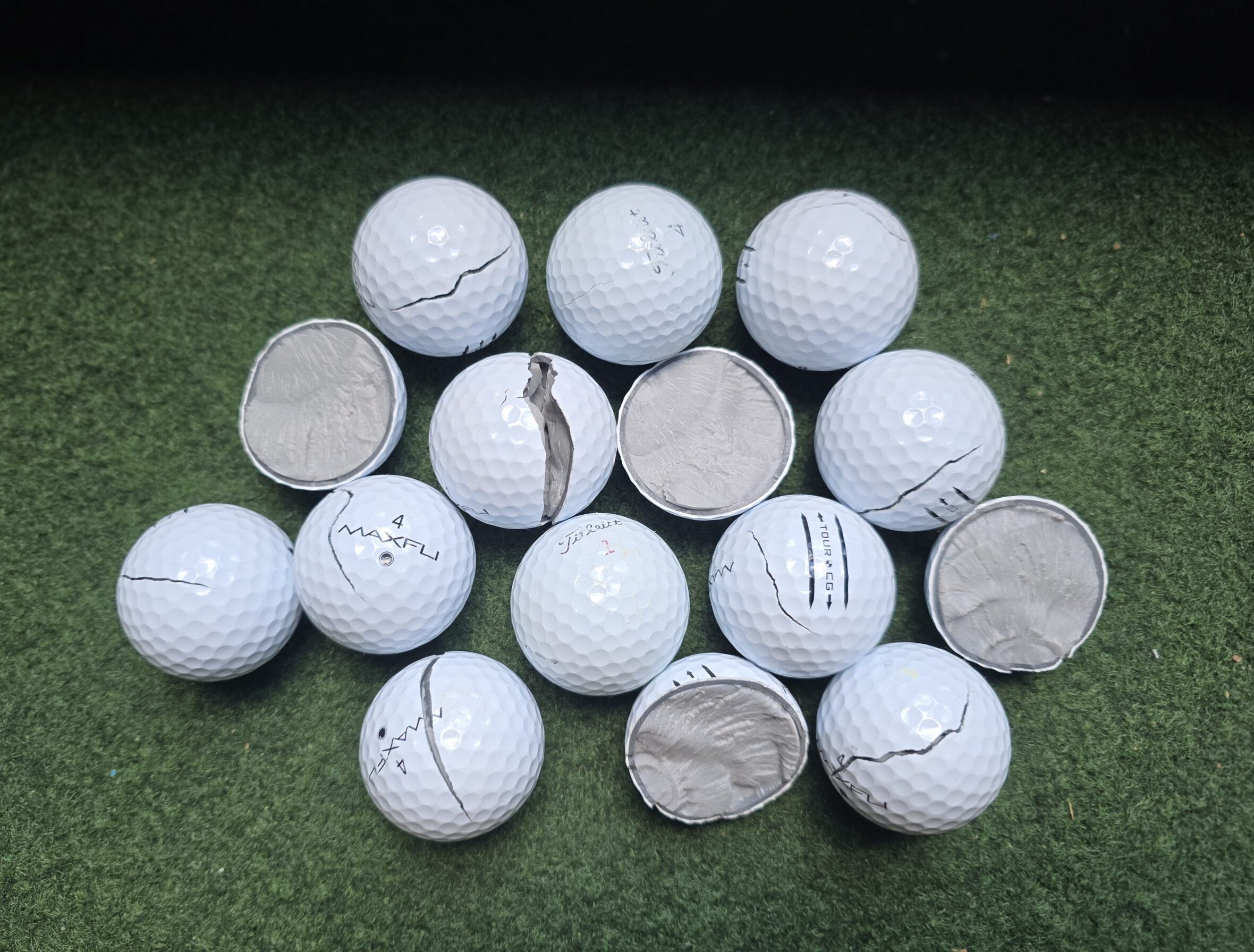
Must Knows About Golf Balls in The Sim
When you’re practicing or playing on a golf simulator, it’s easy to just grab a single ball and get into a groove. After all, there’s no need to walk after your shot, no worrying about losing a ball in the trees, and no one behind you pushing the pace. But if you’re serious about improving your game or making your indoor practice as efficient and realistic as possible, you should absolutely be practicing with the same ball you plan to game, and also using multiple balls during your sessions.
Ball Variability Matters—Even Indoors
Not all golf balls are created equal. Compression, cover material, and spin characteristics vary from one model to the next. Even subtle differences can affect launch angle, spin rates, ball speed, and carry distance—all key data points tracked by your simulator.
Take wedge spin, for example. A Titleist Pro V1 might spin 11,000+ RPM on a well-struck wedge shot, while a lower-compression distance ball like the Titleist Velocity may only spin around 7,000 RPM. That’s a massive difference—4,000 RPM could mean the difference between sticking a shot on the green or watching it release 20 feet past the pin. If you’re only practicing with one ball (or worse, a random mix from the garage), you’re not getting consistent feedback or replicating what you’d experience on the course.
Use the ball you game—or at least test the balls you’re considering gaming—to ensure your simulator sessions provide actionable feedback. If you’re a serious golfer you’ll likely want to have a stable of gamers ready to go based on the course your playing and conditions at any given time.
Worn-Out Balls WILL Damage Your Impact Screen
Sure, a scuffed ball still “works,” but if you’re using balls that are visibly worn, cracked, or peeling, you’re risking more than just bad data—you’re risking your gear. Impact screens aren’t cheap, and repeated hits from damaged covers can cause premature wear, snagging, or even tearing of your screen.
A sharp edge from a cracked urethane cover can dig into mesh screen fibers with every strike, slowly shredding the material. And if you’re using a high-end screen designed for minimal bounceback and clear image projection, you don’t want to shorten its life by using balls that belong in the trash – or better yet, in the bag ready for that next island green.
Keep your investment safe. Rotate in clean balls and retire the beat-up ones.
Heat Cycling Can Break Balls From the Inside Out
Most golfers can hardly keep a ball in play through 18 holes let alone a few hundred, so here’s something most of us have never even considered: your golf ball is going through a physical battle every time you hit it. In a simulator, when you’re hitting the same ball over and over, the core heats up—fast. With each impact, the internal polymers flex and generate friction, building up heat inside the ball.
But here’s the real issue: if you keep hitting that same ball while it’s still hot, you’re compounding stress on materials that haven’t had time to settle. The core is still expanded, the layers are softened, and the next impact only makes it worse. That repeated stress without recovery causes fatigue inside the structure of the ball—and it’s not long before the ball gives out.
Eventually, you’ll see it: spiderweb fractures, splitting covers, and some will even crack in half after a hard swing, which I’ve personally witnessed far too often. If we’re being honest it is pretty cool to split a ball in front of your buddies, but the problem is that it’s not just cosmetic—the ball’s performance is shot way before you can actually see it, and the data you’re getting from your simulator is no longer reliable.
Rotating balls gives them time to cool down and return to a stable state, protecting performance and extending their lifespan, and no one wants to waste a $4 Pro V1.
Better Practice and Club Testing Starts With the Right Ball
If you’re tuning your swing, getting fit for new clubs, or trying to dial in spin and launch numbers, your data is only as good as the ball you’re hitting. Practicing or testing clubs with a ball that behaves nothing like your gamer is nothing short of a waste of time. Make sure you use the same type of ball when testing new clubs.
Want to know how your 7-iron performs with a Pro V1 vs. a TP5x? Or how a softer ball reacts with a partial wedge swing? Using multiple balls during a simulator session makes these tests quick, controlled, and incredibly valuable. Hit 3–5 shots with one ball, then switch. Compare dispersion, launch, spin, and carry—all without leaving your space.
Whether you’re practicing or testing gear, using the ball you actually play—or rotating through a few options—is the only way to get reliable feedback.
Final Thought
Your simulator is a powerful tool for game improvement—but like any tool, how you use it matters. By switching out golf balls regularly and keeping multiple ready to go, you’re treating your practice like it counts. That attention to detail can shave strokes off your game, and you’ll walk onto the course knowing your indoor work translates.
Pro Tip
Keep at least five or more clean, unmarked balls in your rotation. Avoid using balls with marker lines or logos that could rub off on your screen—especially if your screen is high-end and designed for projection. Clean balls protect your gear, preserve performance, and keep your space looking sharp.
Want to build the ultimate simulator setup in Hawaii that lets you get the most out of every ball you hit? Reach out to us at Simulator Golf Solutions Hawaii—we specialize in designing custom, performance-driven environments that make every swing count.
